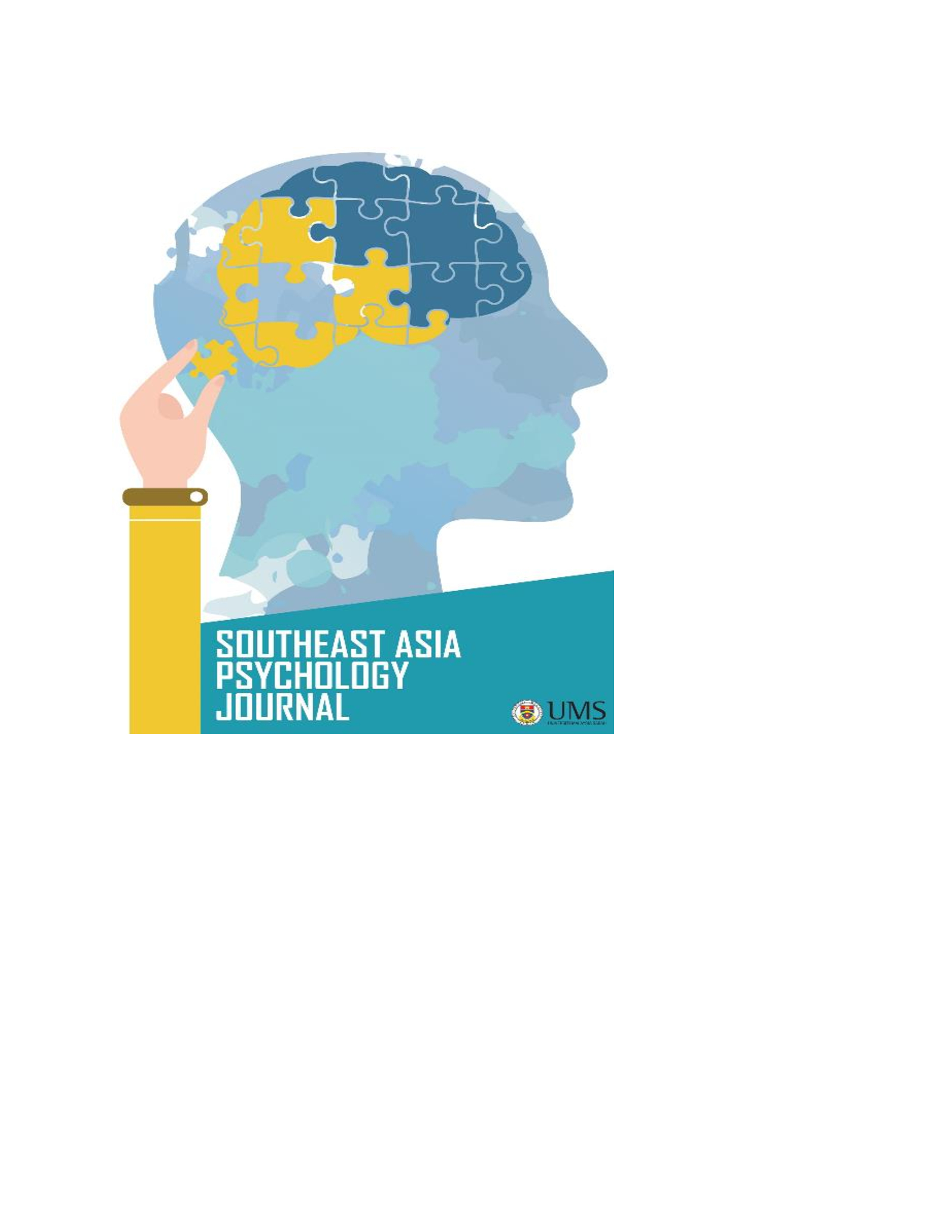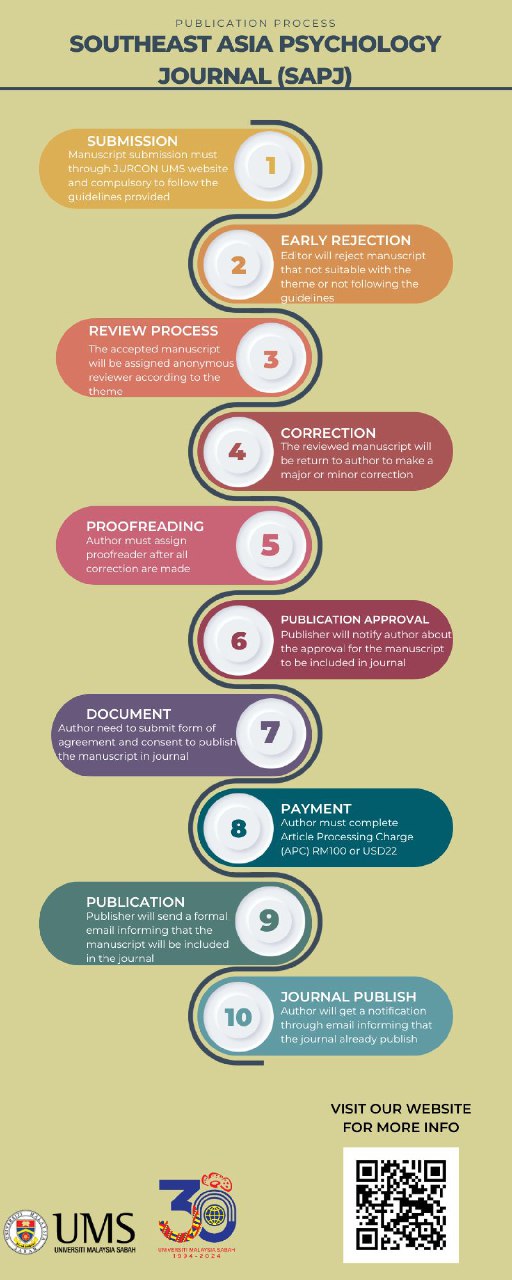PLAYFULNESS AND TEACHER’S SELFEFFICACY OF EARLY CHILDHOOD TEACHERS
DOI:
https://doi.org/10.51200/sapj.v12i1.5053Keywords:
Playfulness, Teacher’s Self-Efficacy, Early Childhood Education TeachersAbstract
This study aims to determine the relationship between playfulness and self-efficacy among early childhood teachers. Playfulness is a personality trait that underlies an individual's tendency to be intrinsically motivated, have a clear orientation toward pleasure, and participate spontaneously and without restrictions. The method used in this research is quantitative research methods with a correlational research design. The tool to measure playfulness is the Adult Playfulness Traits Scale (APTS), which consists of 19 items and Norwegian Teacher Self-Efficacy Scale (NTSES) to measure teacher’s self-efficacy, which consists of 24 items. The subjects of this study (N=52 people) were early childhood teachers. The correlation statistical test in this study uses Pearson product-moment correlation to measure the relationship between variables through the correlation coefficient. The results revealed a significant correlation coefficient between playfulness and teacher's self-efficacy r = -0.398 and p = 0.003 < 0.01, indicating negative relationship between early childhood teachers’ playfulness and teacher’s self-efficacy. In other words, the higher the playfulness, the lower the teacher's self-efficacy among teachers. Hence, the importance of playfulness for teachers to build warm relationships with students in the classroom so that students feel safe, is inseparable from teacher competence which is based on beliefs about their own abilities or self-efficacy.
References
Akyar, B.C & Celik, S.S (2022). Playfulness of early childhood teachers and their views in supporting playfulness. Education, 3-13, 50(1), 1-15.
Barnett, L. (1992). Characterizing Playfulness: Correlates with IndividualAttributes and Personality Traits. Play & Culture, 4: 371–393.
Barnett, L. A. (2018). The Education of Playful Boys: Class Clowns inThe Classroom. Frontiers in Psychology, 9, 232.doi:10.3389/fpsyg.2018.00232.
Bateson, P., & P. Martin. (2013). Play, Playfulness, Creativity, andInnovation. Cambridge: Cambridge University Press.
Bergen, D., R. Reid, & L. Torelli. (2009). Educating and Caring for VeryYoung Children. New York: Teachers College, Columbia University.
Bronson, M., & A. C. Bundy. (2001). A Correlational Study of the Testof Playfulness and the Test of Environmental Supportiveness. Occupational Therapy Journal of Research, 223–224.
Bundy, A. (1997). Play and Playfulness. In Play in Occupational Therapyfor Children, edited by D. Parham, and L.Fazio. 77–92. St. Louis,MO: Mosby Yearbook.
Cansoy, R., Polatcan, M., & Parlar, H. (2018). Research on teacherself-efficacy in turkey: 2000-2017. World Journal of Education, 8(4),133-145. https://doi.org/10.5430/wje.v8n4p133
Feist, J. & Feist, G. (2018). Theories of personality. New York: Mc Graw Hill.
Griffith, A. & Burns, M. (2012). Outstanding Teaching: EngagingLearners. Crown House Publishing. Carmarthen, UK; Bethe, CT,USA.
Henson, R. K. (2002). From adolescent angst to adulthood: Substantiveimplications and measurement dilemmas in the development of teacher efficacy research. Educational psychologist, 37(3),137-150.
Lieberman, J. (1965). Playfulness and Divergent Thinking: An Investigation of their Relationship at the Kindergarten Level. The Journal of Genetic Psychology, 107(2), 219–224.
Lieberman, J. (1967). A Developmental Analysis of Playfulness as a Clue to Cognitive Style. The Journal of Creative Behavior, 1(4). 391–397.
Mangunsong, F. (2011). Psikologi dan pendidikan anak berkebutuhan khusus (jilid pertama). Depok: LPSP3 UI.
Oyola, R.R., Figueroa-Feliciano, V., Torres-Martínez, Y., Torres-Vélez,
J., Encarnación-Pizarro, K., Fragoso-Pagán, S., & Torres-Colón, L.(2018). Play, playfulness, and self-efficacy: Parental experiences with children on the autism spectrum. Occupational therapy international, 3, 1-10.
Pendergast, D., Garvis, S., & Keogh, J. (2011). Pre-service student-teacher self-efficacy beliefs: an insight into the making of teachers. Australian Journal of Teacher Education, 36, 46-58.Pendidikan inklusif hadapi tantangan. (2011). downloaded from http://lipsus.kompas.com/indocomtech2013/read/2011/11/09/2341052/pendidikan.inklusif.hadapi.tantangan.//teko.kompas.com
Pinchover, S. (2017). The Relation Between Teachers’ and Children’sPlayfulness: A Pilot Study. Frontiers in Psychology,8: 2214.doi:10.3389/fpsyg.2017.02214.
Santrock, J. W. (2017). Educational psychology (6th ed.). New York:McGraw-Hill.
Schunk, D. H. (2011). Learning theories. Boston: Pearson Education.
Schunk, P. R., Pintrich, P. R., & Meece, J. L. (2013). Motivation in education: Theory, research, and applications (3rd ed.). New Jersey: Pearson Education.
Shahzad, K., & Naureen, S. (2017). Impact of teacher self-efficacy on secondary school students’ academic achievement. Journal of Education and Educational Development, 4(1), 48-72.
Shin, N. (2004). Predictors of Visual Media Use and Their Effects on Imaginative Playfulness in Preschool Children. PhD diss., Michigan State University.
Singer, E. 2013. Play and Playfulness, Basic Features of Early Childhood Education. European Early Childhood Education Research Journal, 21(2): 172–184. doi:10.1080/1350293x.2013.789198.
Skaalvik, M. E., & Skaalvik, S. (2007). Dimensions of teacher self-efficacy and relations with strain factors, perceived collective teacher efficacy, and teacher burnout. Journal of Educational Psychology, 99, 611-625.
Skilbeck, A. (2017). Dewey on seriousness, playfulness and the role of the teacher. Education Sciences, 7(1), 1-14.
Shen, X. S. (2010). Adult Playfulness as A Personality Trait: Its Conceptualization, Measurement, and Relationship to Psychological Well-being. The Pennsylvania State University, College of Health and Human Development. Pennsylvania: Penn State University Press.
Shen, X. S., Chick, G., & Zinn, H. (2014). Validating the Adult Playfulness Trait Scale (APTS): An Examination of Personality, Behavior, Attitude, and Perception in the Nomological Network of Playfulness. American Journal of Play, 6(3), 345–369.
Tegano, D. W., M. M. Groves, and C. E. Catron. 1999. Early Childhood Teachers’ Playfulness and Ambiguity Tolerance: Essential Elements of Encouraging Creative Potential of Children. Journal of Early Childhood Teacher Education 20: 291–300. doi:10.1080/0163638990200307.
Tschannen-Moran, M., & Hoy, A. W. (2001). Teacher efficacy: Capturing an elusive construct. Teaching and teacher education, 17(7), 783-805.
Wisudawati, W. N., & Damayanti, R. (2021). The Effectiveness Of Parenting Classes In Increasing Parenting Self-efficacy In Early Childhood Parents During The Covid-19 Pandemic. Southeast Asia Psychology Journal, 9(2), 66 – 81.
Wisudawati, W. N. (2023). Descriptive Study Of Teacher Self-efficacy With Gender Perspective In Kindergarten Teachers. The Southeast Asia Psychology Journal, 11(1). 65-77 15







